|
|
|
Sort Order |
|
|
|
Items / Page
|
|
|
|
|
|
|
| Srl | Item |
| 1 |
ID:
184428
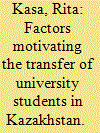

|
|
|
|
|
| Summary/Abstract |
The theoretical frameworks developed for, and applied to, the study of student transfer between higher education institutions build on evidence from Western contexts, specifically the United States. The current article contributes to understanding factors that drive student transfer in the Central Asian context, specifically that of Kazakhstan. Through inductive coding of qualitative interviews with undergraduate transfer students in Kazakhstan, this research identifies student-centred factors of social embeddedness, parental influence in higher education decision-making, evolving career choice awareness, strategies for academic success, the quality of teaching and relationship ethics with students. While these factors influencing student transfer in Kazakhstan align with the existing Western context-based literature, the data in this research offer a localized perspective on what these factors mean in the context of a contemporary Central Asian country.
|
|
|
|
|
|
|
|
|
|
|
|
|
|
|
|
| 2 |
ID:
184421
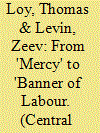

|
|
|
|
|
| Summary/Abstract |
This paper presents the development and transformations of Bukharan Jewish newspapers and periodicals (1910–38) and situates them in the broader Central Asian mediascape. Over a period of 30 years, the Bukharan Jewish press was transformed from a pioneering privately owned enterprise that served the needs of the Jewish communities throughout Central Asia to one owned and regulated by the Soviet state, serving as a tool to transmit propaganda and to shape and educate a predefined ‘national minority group’. The paper argues that the introduction of a Bukharan Jewish press in 1910 was intended to create a modernized language and ethnic awareness among the Jews of Central Asia. In the 1930s, Bukharan Jewish newspapers and journals were radically Sovietized and finally shut down by the state. From then until the collapse of the Soviet Union, no Bukharan Jewish publications appeared in the bloc and the existence of a distinct Central Asian Jewish identity was largely ignored. This case study sheds light on Tsarist and Soviet minorities’ policies and helps us to better understand the various changes experienced and the cultural adaptations made by many ‘minorities’ of Central Asia in the Age of Colonialism.
|
|
|
|
|
|
|
|
|
|
|
|
|
|
|
|
| 3 |
ID:
184420
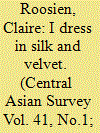

|
|
|
|
|
| Summary/Abstract |
In the 1930s, luxury textiles such as silk and velvet appeared frequently in agitation and propaganda addressed toward women in Uzbekistan. After examining the cultural and material significance of luxury textiles for Central Asian women before collectivization, this article investigates how luxury textiles were used in the effort to mobilize Central Asian women during the years of collectivization and cottonization (c.1929–37). The article concludes with a close reading of several ‘textile-texts’ produced by Central Asian women, focusing particularly on women’s poetry about luxury textiles. The article argues that the discourse of ‘silk and velvet’ tapped into affective resonances rooted in, among other conditions, the local gift economy, Central Asian women’s material conditions, Orientalist discourses and Stakhanovite propaganda. The discourse of silk and velvet thus bolstered hierarchical relations between Central Asian women and the Party–state, while at the same time it generated lateral ties to a public of other Central Asian women. The article relies on research in a variety of archival sources and the Uzbek-language Soviet press, particularly the women’s press.
|
|
|
|
|
|
|
|
|
|
|
|
|
|
|
|
| 4 |
ID:
184422


|
|
|
|
|
| Summary/Abstract |
This article looks at how the changing relationship between science and religion from the fin de siècle to the present period continues to influence healing practices in Mongolia. It explores how science and religion, rather than being congenitally antithetical to one another, are frequently co-constitutive. By following a few key historical lineages of spiritualism in their dialogue with the Mongolian cultural region, the article illustrates how ongoing exchanges between science and religion have contributed to changes in contemporary Mongolian urban religious practices. As the article illustrates, science, and/or the idea of science, has resulted in changes to lay religious epistemologies and methodologies. At the same time the prestige of science can be used as a means of underlining the strength of ritual efficacy, particularly within Buddhism. Yet when science or allopathic medicine fails to explain or to heal, science is used as a yardstick against which the transcendent power of ritual becomes evident.
|
|
|
|
|
|
|
|
|
|
|
|
|
|
|
|
| 5 |
ID:
184425
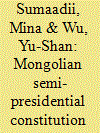

|
|
|
|
|
| Summary/Abstract |
While earlier studies of Mongolian democracy focused on actor-based explanations for its success, this study discusses the previously less examined role of Mongolia’s semi-presidential constitution in the process of democratization. It examines how the semi-presidential political system in Mongolia evolved since 1992 and offers an in-depth examination of the Mongolian semi-presidential form of government institutionalized by the 1992 constitution and its subsequent amendments. Based on this, it also addresses the question of whether the Mongolian semi-presidential constitution was a weakness or a strength to democratization. This study argues that at an early stage when the political forces were learning the rules of the game, the constitution was an overall positive influence on democratization. Moreover, the main weaknesses linked to the constitutional design were more likely to be related to weak institutional control mechanisms that could be resolved at a lower level legal framework.
|
|
|
|
|
|
|
|
|
|
|
|
|
|
|
|
| 6 |
ID:
184426
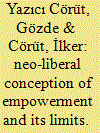

|
|
|
|
|
| Summary/Abstract |
Through qualitative research conducted in the bazaars of Bishkek, this paper examines the posited tripartite relationship between the free market, micro-finance and women’s empowerment by focusing on how loans from micro-finance institutions in Bishkek influence the lives of female loanees. The neo-liberal conception of ‘individual autonomy’ and ‘empowerment’, it is argued, may not adequately serve as indicators of actual female empowerment/disempowerment in Bishkek and lead us to fail to recognize moments of self-exploitation and forms of claim-making. The research also underlines the disempowering effects of the affectional burden, that is, the constant sense of anxiety, that the loanees have to manage in order to survive in the neo-liberal business environment, which offers high interest rate loans and exposes the loanees to over-indebtedness. These effects can be followed through the analysis of the role the desire for stability and ‘ontological security’ plays in the formation of the identities/world views of the loanees.
|
|
|
|
|
|
|
|
|
|
|
|
|
|
|
|
| 7 |
ID:
184427
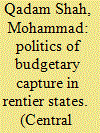

|
|
|
|
|
| Summary/Abstract |
The literature of fiscal federalism suggests two approaches to explaining the allocation of intergovernmental transfers. First, a normative approach that considers governments as benevolent social planners pursuing normative criteria of efficiency and equity; and second, a public choice approach assuming governments as self-maximizing actors who use intergovernmental transfers to purchase political capital, enhancing their chances of re-election. This paper seeks to test the hypotheses of these two approaches to explain the allocation of discretionary development budget among Afghan provinces during three fiscal years of 2016–17, 2017–18 and 2018–19. Findings indicate Afghanistan’s central government’s approach does not focus to achieve normative criteria of improved participation, predictability, transparency, and equity. Instead, Its central government considers certain political criteria such as political affiliation – ethnic affiliation and alignment with central government policies – political importance, and strength and weakness of local actors. This paper relies on both quantitative and qualitative data to support its arguments.
|
|
|
|
|
|
|
|
|
|
|
|
|
|
|
|
| 8 |
ID:
184429


|
|
|
|
|
| Summary/Abstract |
The emerging and vibrant field of environmental humanities to date has not received considerable attention in Central Asia. In light of the Anthropocene crises, there is a real urgency for maturing this field and investigating the methodological and epistemological challenges that environmental topics demand, often working across disciplinary habits and time scales. This roundtable brings together Central Asianists from a range of backgrounds to discuss the sources and scales of their investigation, their challenges and potential. The contributors discuss how particular kinds of sources such as climate models, archival manuscripts, ethnographic fieldwork and media analyses have been used to understand environmental changes in the region. In what ways do the traditions of scholars’ disciplinary training guide the scale of analysis? Looking toward the future of environmental humanities in Central Asia, this roundtable suggests paths for developing this vital field of enquiry.
|
|
|
|
|
|
|
|
|
|
|
|
|
|
|
|
| 9 |
ID:
184423
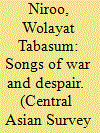

|
|
|
|
|
| Summary/Abstract |
This study explores two adult women’s self-authored and self-composed songs and life history in a north-eastern province of Afghanistan. The women did not sing to entertain the researcher or their visitors. Instead, they sang in the form of lament to express their grief. The author argues that by singing, women create a space in which they lament, communicate with their lost loved ones and criticize political ongoings that resulted in despair. The study also explores how the women cope with their inner feelings and sufferings that are the outcome of more than four decades of civil unrest in the country.
|
|
|
|
|
|
|
|
|
|
|
|
|
|
|
|
| 10 |
ID:
184424


|
|
|
|
|
| Summary/Abstract |
Women’s role in herding and their empowerment in Mongolian herding households has been little studied, and their participation in decision-making can have important implications for rural households. We draw on a unique sample of 60 Mongolian herding households carried out in 2017 to provide evidence for how herding work and related decision-making is shared between husbands and wives. We extend previous work by using a much more detailed survey, asking about participation in 22 different activities related to herding and 39 decisions, and by analysing factors associated with greater participation in herding decisions by Mongolian women. We show that most herding tasks are not gendered, and, in many tasks, women contribute more time than men. Women made few herding-related decisions alone, and they participate jointly with their spouses in about half the decisions, many fewer than men. Women who contribute more to herding income through milk and cashmere production have more input into many decisions; more educated women have greater participation in some decisions. These findings suggest policy paths toward greater equality and improved outcomes in Mongolian herding households.
|
|
|
|
|
|
|
|
|
|
|
|
|
|
|
|
|
|
|
|
|